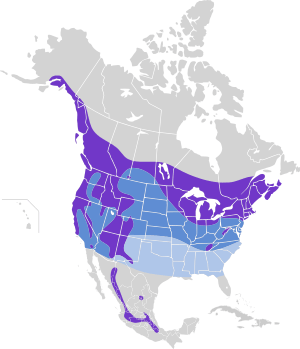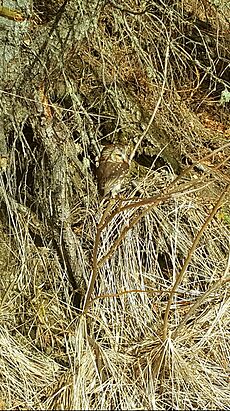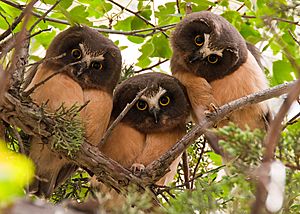Northern saw-whet owl facts for kids
Quick facts for kids Northern saw-whet owl |
|
|---|---|
 |
|
| Conservation status | |
| Scientific classification | |
| Genus: |
Aegolius
|
| Species: |
acadicus
|
| Subspecies | |
|
Aegolius acadicus acadicus |
|
 |
|
| Geographical distribution of the Northern saw-whet owl. Year-round Nonbreeding Nonbreeding (scarce) | |
| Synonyms | |
|
Nyctala acadica |
|
The northern saw-whet owl (Aegolius acadicus) is a tiny and amazing species of owl found across North America. These owls are some of the smallest on the continent. They often hide in thick bushes or trees, sometimes right at your eye level! Because they are so small, bigger birds of prey can sometimes hunt them. Northern saw-whet owls are known to travel, or migrate, but they don't always follow the same path each year.
Contents
Meet the Northern Saw-whet Owl
These owls are quite common but can be tricky to spot. They are about the same size as an American robin. They are known for their unique calls, which sound a bit like a saw being sharpened.
What's in a Name?
The northern saw-whet owl was first officially described in 1788 by a German scientist named Johann Friedrich Gmelin. He gave it the scientific name Strix acadicus. This name came from "Acadia," which was an old French colony in Nova Scotia, Canada. Later, in 1829, another scientist, Johann Jakob Kaup, placed it in a new group called Aegolius. The name Aegolius comes from a Latin word for a type of owl, which itself came from an Ancient Greek word meaning "a bird of ill omen."
There are two main types, or subspecies, of the northern saw-whet owl:
- A. a. acadicus: This type lives in southern Alaska, Canada, much of the USA, and northern Mexico.
- A. a. brooksi: This type is found only on the Haida Gwaii islands off the coast of British Columbia, Canada.
How to Spot a Saw-whet Owl
Northern saw-whet owls are small, usually about 17 to 22 centimeters (7 to 9 inches) long. Their wings can spread out to about 42 to 56 centimeters (17 to 22 inches). They weigh around 80 grams (about 3 ounces), which is very light!
It's hard to tell male and female saw-whet owls apart just by their feathers. However, females are usually a bit larger and heavier than males. Females weigh about 100 grams, while males weigh around 75 grams. A cool fact about their feathers is that they glow neon pink under a special UV light! Scientists use this to learn about their age and when they change their feathers.
These owls have a round, pale white face with brown and cream stripes. They have a dark beak and bright yellow eyes. Their undersides are light with dark patches, and their upper parts are brown or reddish with white spots. Young owls look a bit different, with dark brown heads and wings, and a rusty-colored chest and belly. They also have a clear white, Y-shaped mark between their eyes.
Saw-whet owls can sometimes be confused with boreal owls. But saw-whets are smaller, have a different beak color, and don't have spots on their forehead.
Sounds of the Saw-whet Owl
The northern saw-whet owl makes a repeated "tooting" whistle sound. Many people say it sounds like a saw being sharpened on a whetstone – that's how it got its name! Males often make these calls when they are looking for a mate. You can hear them more often from January through early July, during their breeding season. They do make sounds all year round, though. Their main "too-too-too" call can be heard up to 300 meters away in a forest.
Scientists have recorded at least 11 different sounds these owls make. These include calls for advertising, rapid calls, whines, and even squeaks. Young owls and adults also snap their bills as a warning if something gets too close.
Where Do They Live?
These owls live in coniferous forests, or sometimes in mixed or deciduous woods, all across North America. During the breeding season, most prefer dense conifer forests near wet areas. However, some also breed in mixed forests in the southern parts of their range. In winter, they like conifer stands or thick bushes near water.
Northern saw-whet owls don't build their own nests. Instead, they use natural holes in trees or old holes made by woodpeckers. Some owls stay in the same area all year, while others fly south for the winter or move to lower elevations. Their home range covers most of North America, from southern Alaska and Canada down through most of the United States and into the central mountains of Mexico.
Some populations in the eastern United States, like those in the Allegheny Plateau and southern Appalachian Mountains, are unique. In some areas of North Carolina, the northern saw-whet owl is listed as a threatened species. This is because they are losing their forest homes due to things like logging and pollution.
Life and Habits
Northern saw-whet owls are mostly active at night. They are very good at hunting in the dark.
Reproduction and Family Life
Northern saw-whet owls usually lay about four to six white eggs in tree cavities or old woodpecker holes. The male owl will often sing from a nest site and even hide food there to attract a female. Once the eggs hatch, the father owl does most of the hunting for food. The mother owl stays with the young and keeps them safe.
Sometimes, a mother owl might have more than one family in a single breeding season! After the first set of owlets grow their feathers, the mother might leave the father to care for them. She then goes to find another male to start a new family with. This is a special way of raising young.
These owls sometimes compete with other birds and animals, like boreal owls, starlings, and squirrels, for nesting spots. Their nests and young can also be eaten by predators such as martens and corvids (like crows). Larger hawks and owls can also hunt saw-whet owls of any age.
What's for Dinner?

Northern saw-whet owls have amazing hearing! Their ears are not perfectly symmetrical, meaning they are slightly different shapes and positions. This helps them figure out exactly where sounds are coming from. Because of this, they can hunt in complete darkness just by listening. They often wait on a high branch at night and then swoop down silently on their prey.
They mostly eat small organisms, especially tiny mammals. Studies have shown that their diet is often 88% to 100% mammals. They particularly love deer mice, voles, and shrews. They might also eat other small mammals like chipmunks, red squirrels, and even bats.
Sometimes, they will also eat small birds like swallows, sparrows, and chickadees. On the Pacific coast, they might even snack on crustaceans, frogs, and water insects. Like many owls, their excellent hearing and sharp vision in low light make them fantastic hunters.
Lifespan
Most Northern saw-whet owls live for about 3 to 5 years in the wild. The oldest known wild Northern Saw-whet Owl was a female that was at least 9 years and 11 months old when she was recaptured and rereleased during banding operations in Minnesota.
With protection from predators, starvation, and disease, they can live significantly longer. Lifespans of 10 years or more are possible in captivity.
See also
 In Spanish: Tecolote afilador para niños
In Spanish: Tecolote afilador para niños




